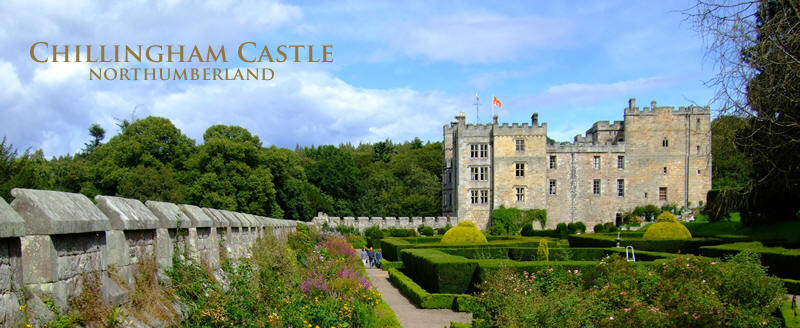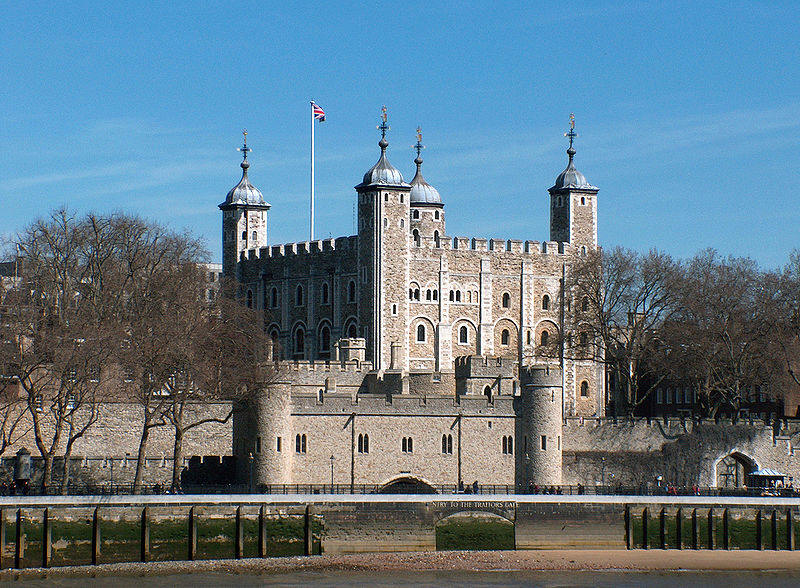
The History
The timeline above provides a detailed look into the history of England. The material covered on the timeline is material you find in textbooks and were taught in school if you took British studies.
Castles are another great source to find History. Personal history and international known history. Take a look at these two stunning, mysterious and historical castles that can be found around England.
 |
Its current owners market the castle as being the most haunted castle in Britain. It has been investigated on television and radio (namely, Most Haunted, I'm Famous and Frightened!, Scariest Places On Earth, Holiday Showdown, Alan Robson's Nightowls) and now Ghost Hunters International.
The most famous ghost of the castle is the "blue (or radiant) boy", who according to the owners used to haunt the Pink Room in the castle. Guests supposedly reported seeing blue flashes and a blue "halo" of light above their beds after a loud wail. It is claimed that the hauntings ceased after renovation work revealed a man and a young boy inside a 10-foot-thick wall. Documents dating back to the Spanish Armada were also found within the wall. When the bodies were found small marks were found etched into the wall and when the remains of the boy were examined, experts found the tops of his fingers (on his bones) had been worn down. This has lead people to believe the boy had scratched at the wall so hard to escape he destroyed his own fingers. The owners also claim that the ghosts of John Sage, a former torturer, and of Lady Mary Berkeley haunt the castle. John Sage was also known as 'Drag Foot' due to the fact he had ligaments torn in one foot from a previous battle with the Scottish which made his foot useless and unliftable. Guests have reported hearing screams for help and doors slamming mysteriously; said to be the man found in the brick wall.
Tower of London

Her Majesty's Royal Palace and Fortress, more commonly known as the Tower of London (and historically as The Tower), is a historic fortress and scheduled monument in central London, England, on the north bank of the River Thames. It is located within the London Borough of Tower Hamlets and is separated from the eastern edge of the City of London by the open space known as Tower Hill. It is the oldest building used by the British government.
The Tower of London is often identified with the White Tower, the original stark square fortress built by William the Conqueror in 1078. However, the tower as a whole is a complex of several buildings set within two concentric rings of defensive walls and moat.
The tower's primary function was a fortress, a royal palace, and a prison (particularly for high status and royal prisoners, such as the Princes in the Tower and the future Queen Elizabeth I). This last use has led to the phrase "sent to the Tower" (meaning "imprisoned"). It has also served as a place of execution and torture, an armoury, a treasury, the Royal Mint, a public records office, an observatory, and since 1303, the home of the Crown Jewels of the United Kingdom.
Today the Tower of London is cared for by an independent charity, Historic Royal Palaces, which receives no funding from the Government or the Crown.
The Prisoners in the Tower of London
The Tower of London is admired for its architecture and its history but it is most remembered for the bloody executions, imprisonment and torture of the prisoners who were incarcerated in the great London castle. Below is some information on a few of the executions that happened at the Tower.
Executions- Beheading
13th June 1483
William Hastings
William Hastings, 1st Baron
Hastings (1431 - 1483)
William Hastings fought to secure the throne for
Edward IV. He was appointed Lord Chamberlain in 1461. When King Edward died
in 1483 he was a staunch and loyal supporter of King Edward's young son -
Edward V, one of the tragic little
Princes in the Tower.
He was arrested on charges of treason by the dead King Edward IV's brother
Richard on route to the young prince's coronation. The two little
princes were declared illegitimate and, as next in line to the throne, their
uncle and Protector, Richard, Duke of Gloucester, was declared the true King
and was crowned Richard III. The two little princes were never seen again.
And William Hastings was executed without trial.
19th May 1536
Queen
Anne Boleyn
Anne Boleyn, Queen of England
(1507- 1536)
Anne Boleyn was the second wife of King Henry VIII. He
divorced his wife, Katherine of Aragon, broke with Rome and was
excommunicated, for the love of this woman. Then lost interest, fell in love
with Jane Seymour and had her arrested on the charges of treason, adultery
and incest with her brother George Boleyn, Lord Rochford. Anne Boleyn
entered the Tower of London via Traitor's gate where she was met by William
Kingston, the Constable of the Tower. She asked whether she was to be taken
to a dungeon but was assured she would be imprisoned in the Royal apartments
where she spent her time before her coronation. Death by the axe was a
terrifying prospect. The executioners often took several blows before the
head was finally severed. Anne was therefore granted some clemency and a
swordsman was called from France to undertake the execution. When she talked
of her execution and referred to the comforting fact that she "only had a
little neck."
27th May 1541
Margaret Pole, Countess of Salisbury
Margaret Pole, Countess of Salisbury (1473-1541)
The
Countess of Salisbury was the last direct descendant of the Plantagenet line
- she was as descendent of King Edward III. The countess made the mistake of
appearing to side with Katherine of Aragon against the king and he declared
her a traitor. She was arrested two years before her execution and badly
treated and neglected as a prisoner in the Tower of London. She was not
given a trial. She was small, frail and ill. But she was a proud noble. She
was dragged to the block, but refused to lay her head on the block. She was
forced down and struggled. The inexperienced executioner made a gash in her
shoulder rather than her neck. She leapt from the block and was chased by
the executioner, with his axe. She was struck eleven times before she died.
There were 150 witnesses to her execution. She was 68.
13th February
1542
Catherine Howard
Catherine
Howard, Queen of England (1524 - 1542)
Catherine Howard was the pretty fifth wife of King
Henry VIII and the cousin of Anne Boleyn. Henry was besotted with her,
calling her his 'Rose without a Thorn' and showered her with gifts and
public affection. She had led a permissive life in the household of her
grandmother, the Dowager Duchess of Norfolk. and was an uneducated,
neglected girl. After her marriage to Henry VIII who was an old, repulsive,
obese man, she had an affair with the young and handsome Thomas Culpepper.
And was found out. King Henry was devastated. Catherine was arrested at
Hampton Court for adultery and tried in vain to reach the King. She was
dragged screaming back to her apartments. Her lovers were executed and she
passed their gruesome, impaled heads on London Bridge on her way to
Traitor's gate, the entry to the Tower of London. Catherine asked William
Kingston for a block so that she could practise her execution. Legend has it
that Catherine's last words were: "I die a queen, but would rather die the
wife of Culpepper." She was just 18 years old.